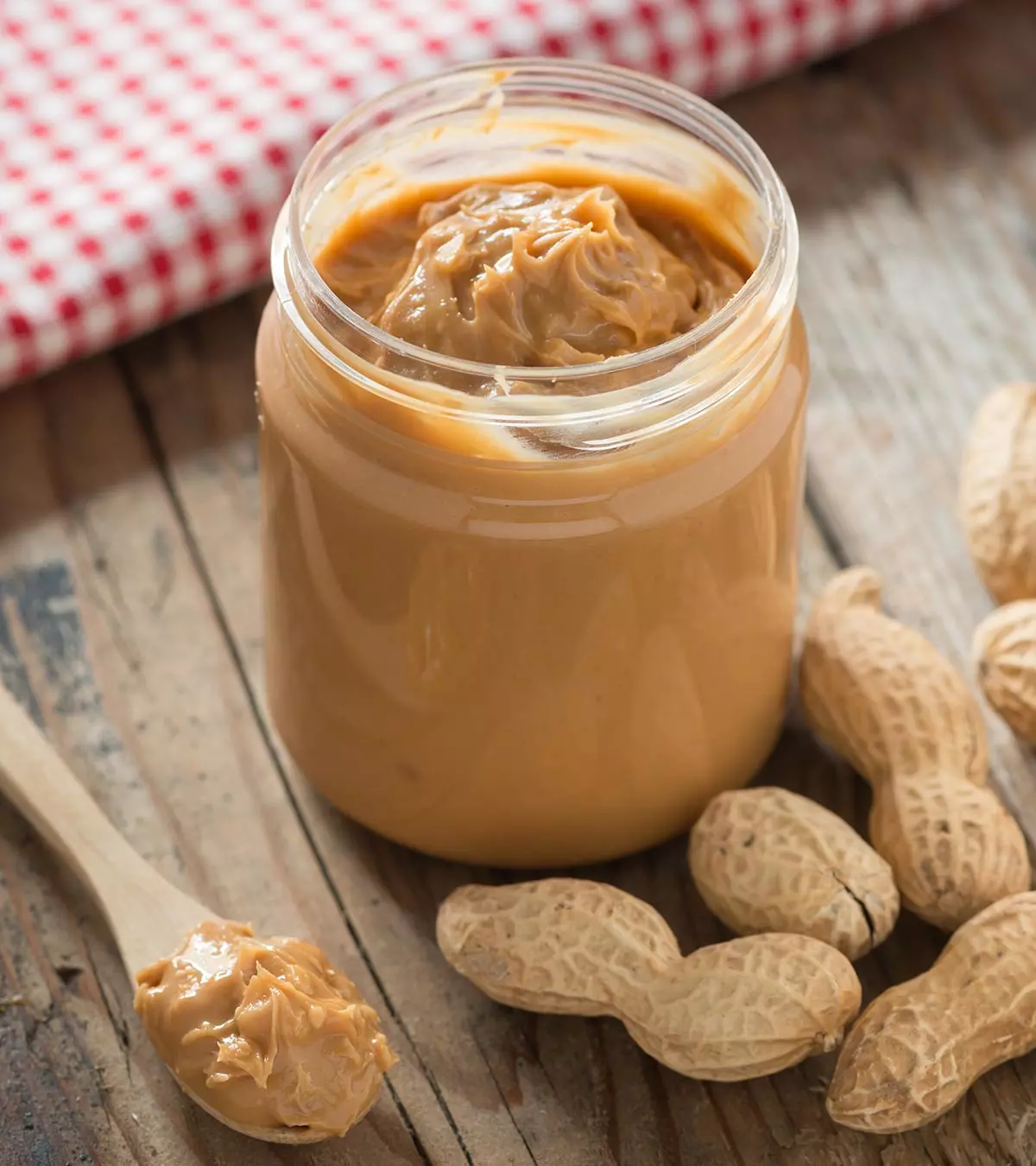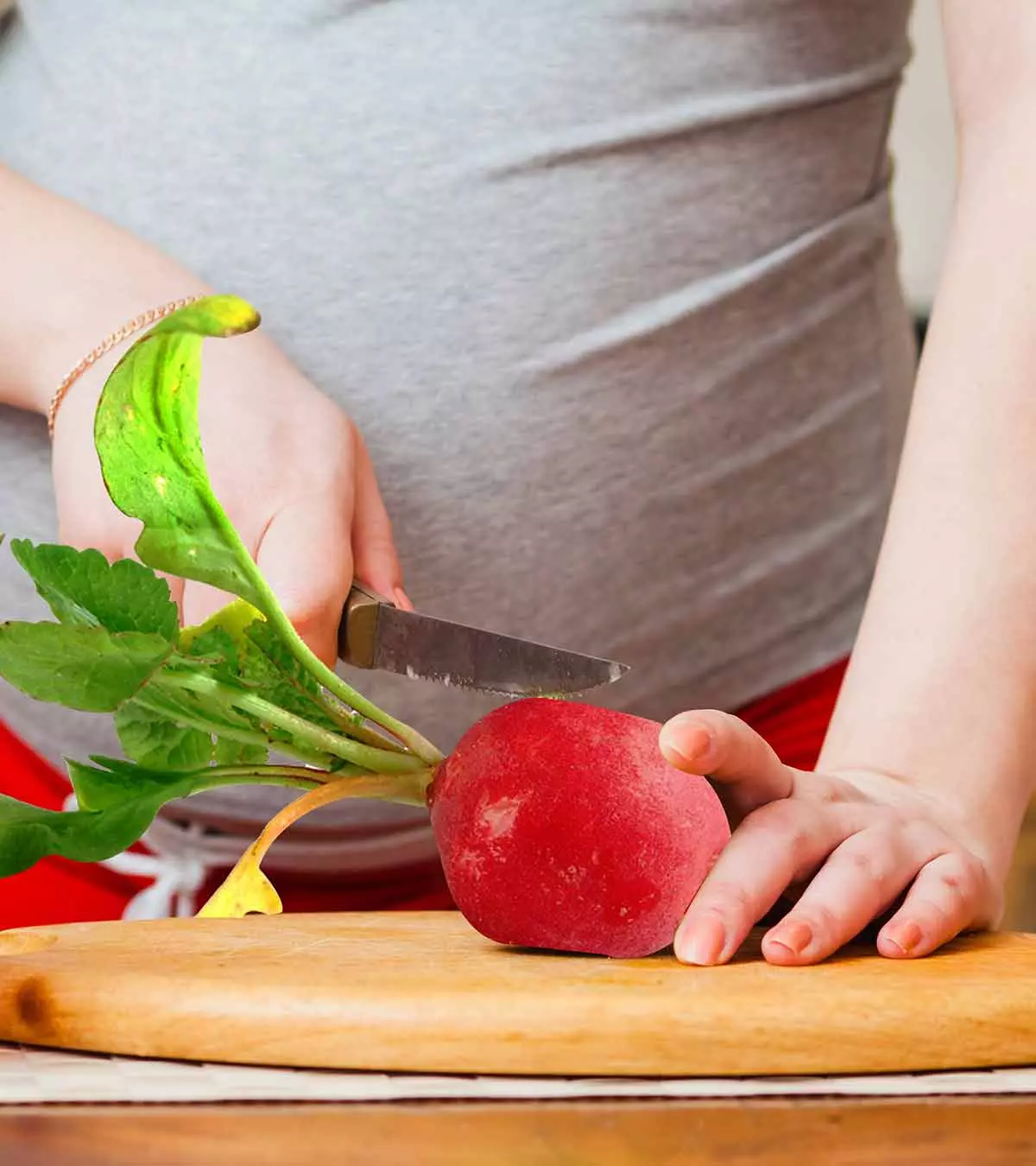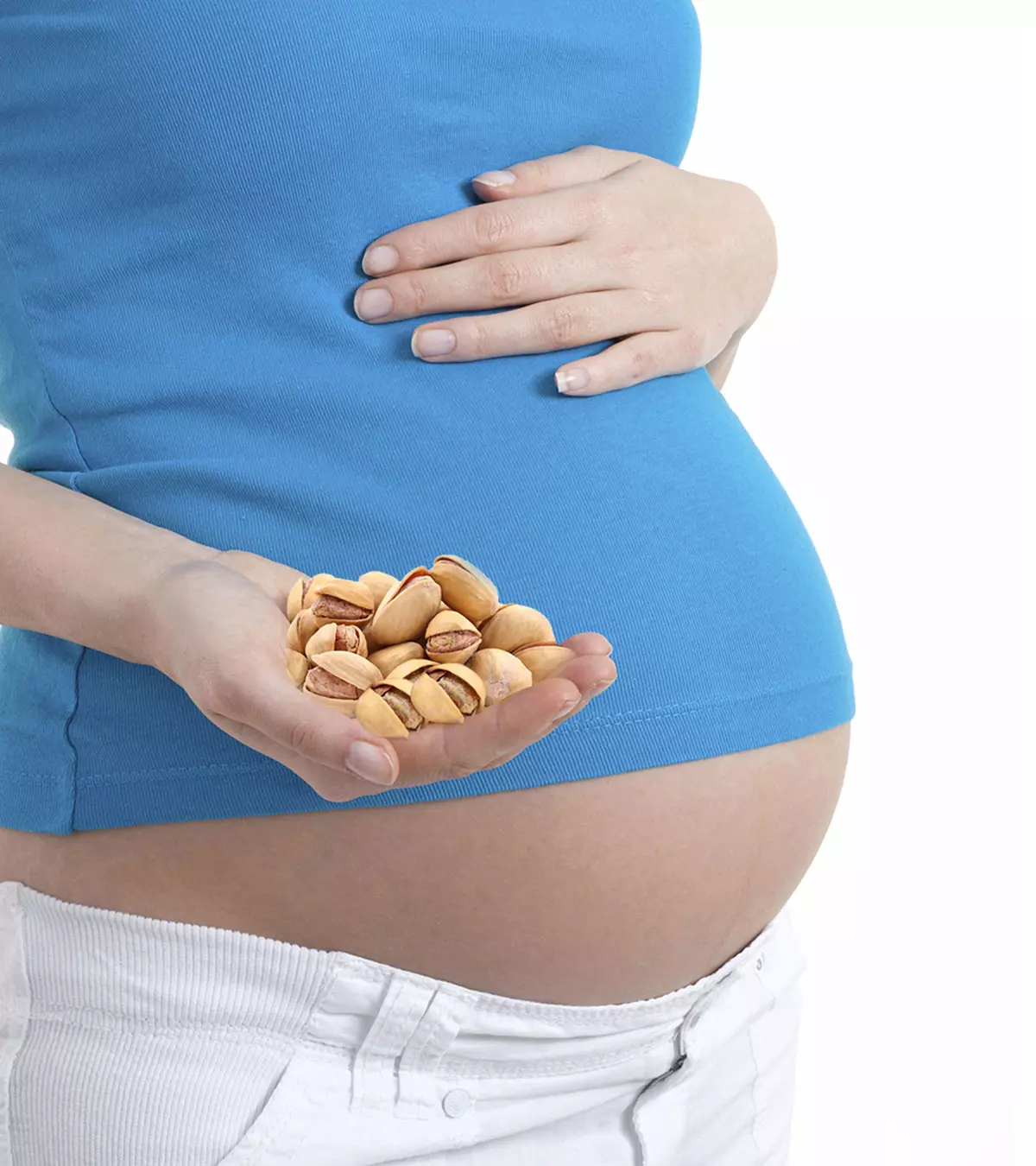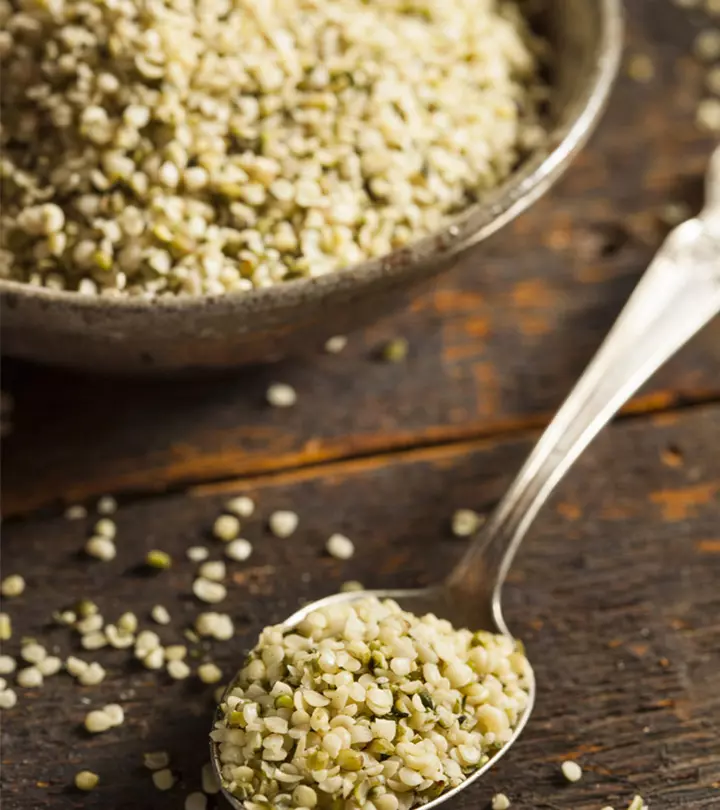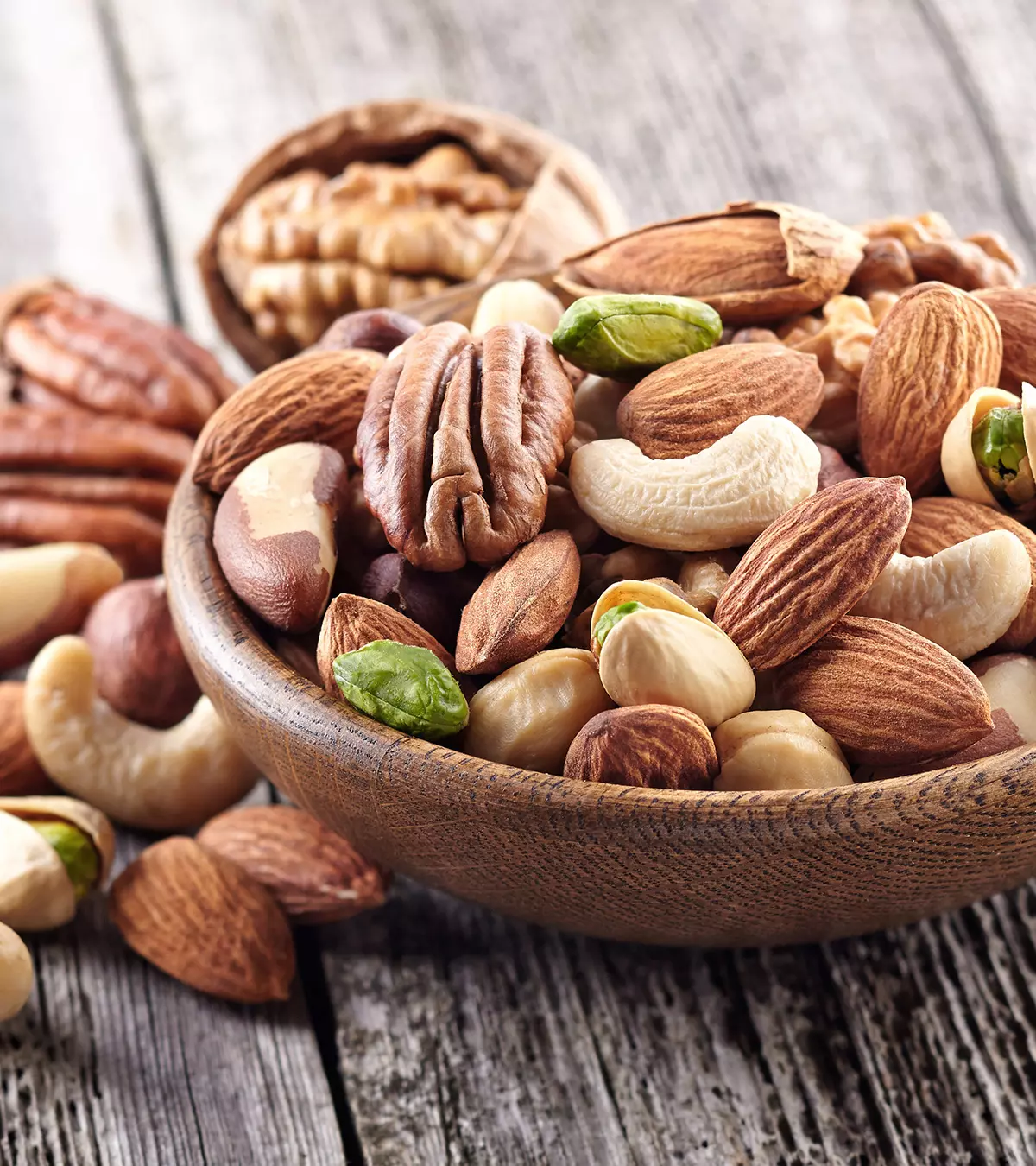
image: Shutterstock
Once your baby shifts to solid food, you could be thinking about including nuts in their diet. Nuts for babies can benefit their overall health by offering several essential nutrients and healthy fats. Besides, adding a few nuts to a preparation could enhance its texture and flavor.

Nuts are one of the best-known natural food items that most people consume to boost their health and immunity. But, being a potential allergen, you may have a few safety concerns about giving nuts to your baby.
Explore the health benefits and side effects of nuts for babies, along with the right age and ways to introduce nuts to your little one.
Key Pointers
- Nuts can be introduced by the age of six months in babies.
- The energy and nutrient-rich nuts come with several benefits and improve gut health and immunity in babies.
- However, it is best to feed small quantities of nuts initially to check for allergies and side effects.
- If your baby is comfortable, scroll down for some delicious nut recipes.
Is It Safe To Feed Nuts To Babies?
Nuts may usually be safe for babies when fed in age-appropriate ways. However, considering their allergenic nature, experts advise consulting a pediatrician before introducing nuts in baby food recipes. It is preeminent if the baby has other food allergies or has a family history of allergies (1). You may consider cashews, walnuts, hazelnuts, pistachio, pecans, peanuts, and almonds for babies.
When Should You Introduce Nuts To Babies?
In contrast to their previous recommendation, the American Academy of Pediatrics (AAP) recommends introducing potentially allergenic foods to babies between four and six months of age (2). According to experts, early introduction of possibly allergenic foods may help prevent food allergies (3). If you are unsure about feeding nuts to your babies from an early age, discuss your doubts with your healthcare provider.
Age-Appropriate Ways To Introduce Nuts To Babies
Once you get the pediatrician’s approval, introduce nuts in age-appropriate ways. For young babies who have just started eating solids, choose feeding nuts as nut powder added to breast milk or formula or nuts flour used to make cakes or pancakes.
Alternatively, you can feed nut puffs dissolved in different liquid foods, such as puree or breast milk. Once the baby adjusts to the nut’s taste and digestibility, you can feed them nut snacks like smooth nut butter spread over a bread slice or cracker. Avoid feeding nut butter globs, chopped nuts, and chunky nut butter since they are potential choking hazards (4).
 Point to consider
Point to considerNutritional Benefits Of Nuts For Babies
Nuts contain nutrients that can facilitate the infant’s nutrition, growth, development, and sustenance. Here are some benefits of adding different types of nuts to your baby’s diet.
1. Nuts are energy-dense foods. One-fourth cup of almonds offers about 208kcal, while cashew and walnuts give 182kcal and 166kcal of energy, respectively (5). Optimum energy intake is essential to meet the rapid development needs of babies and toddlers.
2. Nuts contain vital nutrients. Almonds, walnuts, and cashew contain healthy fats and nutrients, such as vitamin E, calcium, iron, zinc, magnesium, and folateiNaturally occurring form of vitamin B9, responsible for protein metabolism and the production of red blood cells . These could support a baby’s physiological functions, such as brain and eye development, nerve transmission, and enzyme function (6) (7).
3. Nuts offer healthy plant protein and fiber. Optimum nut protein intake is essential for the baby’s growth, hormone production, enzyme function, and cellular repair. Similarly, dietary fiber consumption is vital for healthy bowel movement and robust gut health. Research has shown that good gut health is essential for an effective immune system (8).
4. Nuts have bioactive compounds such as carotenoidsiColored pigments found in plant-based foods that act as a precursor in the synthesis of vitamin A and protect cells from damage , polyphenolsiNaturally occurring antioxidant compounds found in food items such as fruits, vegetables, coffee, tea, and wine , flavonoids, and phenolic compoundsiBioactive molecules found in plants that are known to have several health benefits . These phytochemicals possess antioxidant effects, which may improve one’s long-term health. Resveratrol is one such compound in pistachio that may hold immunomodulatory propertiesiThe ability of a substance to boost or inhibit the function of the immune system (9) (10). Besides, some nuts contain phytosterols that lower cholesterol and maintain heart health (11).
Precautions To Take While Feeding Nuts To Babies
Below are some necessary precautions to ensure nuts’ safe consumption in babies.
1. Introduce nuts based on your child’s age. Start by adding finely ground nut powder or nut butter to familiar foods such as porridge or yogurt.
2. Maintain a “three-day wait” rule when introducing nuts to babies. Ensure you feed no new food during this period.
3. Keep a close watch on signs and symptoms of discomfort or allergic reaction. If the baby looks uncomfortable after ingesting nuts, discontinue feeding immediately. After a week or more, reintroduce nuts to the baby’s diet. If the discomfort reappears or persists, consult a pediatrician.
4. Gradually increase the quantity as the baby adjusts to the nuts’ taste and digestibility.
5. Allergies to nuts are common so feed nuts to babies after consulting a pediatrician, especially if your baby is allergic to other foods or has a family history of tree nut allergies. Almond, cashew, hazelnut, pecan, pistachio, and walnut tend to cause allergies more commonly (12).
6. Allergic reactions to tree nuts vary in severity from one baby to another. Some of the tree nut allergy symptoms you may notice during an allergy episode are hives, abdominal discomfort, nausea, nasal congestion or runny nose, difficulty swallowing, and itchy mouth and throat. In severe cases, shortness of breath could occur, leading to a potentially life-threatening condition called anaphylaxis (13). Also, according to the American College of Allergy, Asthma, and Immunology (ACAAI), tree nuts are among the eight most likely foods that can cause 90% of allergic reactions in around 4% to 6% of children.
7. If your baby is allergic to a tree nut, they are highly likely to be allergic to other foods called nuts, such as peanuts, which are legumes. In such cases, you must avoid feeding all types of nuts to the baby and instead go for nut-free options (13). Additionally, you also need to avoid other nut products, such as nut oils, nut milk-based food products, and foods that may get cross-contaminated with nuts during processing and manufacturing processes.
8. If the baby doesn’t have a nut allergy, you may try several exciting ways to add nuts to your baby’s or toddler’s diet. For instance, you can add the nuts powder to your baby’s soup or porridge or make nuts flour bread.
9. You can add finely chopped nuts to yogurt or salads for the toddler’s snacks. Avoid feeding whole nuts to children younger than five years of age (14).
10. Nut milk, such as almond milk, is another option that you may try as part of different baby-friendly recipes for your baby.
Healthy And Tasty Nut Recipes For Babies
Here are some tasty and easy-to-prepare nut recipes that you can feed to your baby with relative ease.
1. Steamed apple and walnut mash (6 months)
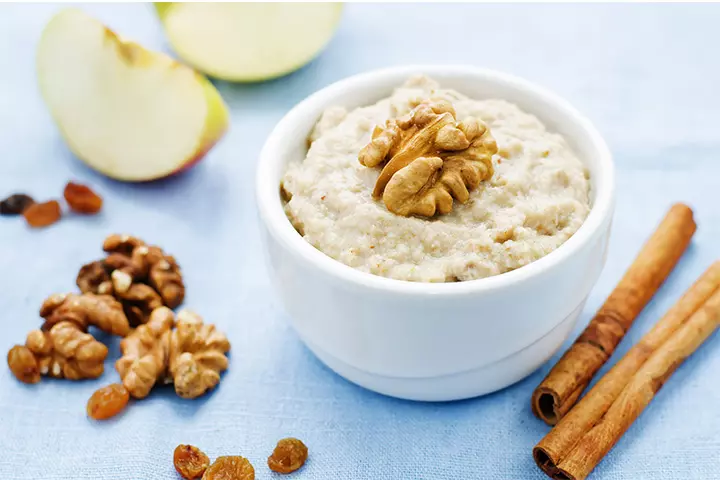
You will need:
- ½ apple (de-skinned and steamed)
- ½ tsp walnut (steamed)
- Breast milk or formula (optional)
How to prepare:
- Blend steamed apple and walnut into a smooth, lump-free mash using a blender or food processor.
- Pour the mash into a feeding cup and adjust the mash’s consistency by mixing some breast milk or formula.
- Feed the mash immediately or store it in an airtight container in a refrigerator.
2. Almond and strawberry oatmeal (8 months)

You will need:
- 1½ cup water
- ½ cup steel-cut oats
- ¼ cup strawberry (pureed)
- 1tsp almond powder
- ½ tsp jaggery powder
How to prepare:
- Cook oats with water as per instructions given on the packet.
- Once oats are ready, stir in strawberry puree, almond powder, and jaggery powder. Mix everything thoroughly.
- Pour the oats into a feeding bowl and feed the baby.
3. Peanut butter and jam sandwich (10 months)

You will need:
- 2 bread slices (corners removed)
- 1tbsp pineapple jam (or any other jam of your choice)
- 1tbsp smooth peanut butter
How to prepare:
- Apply jam on one bread slice and peanut butter on another.
- Put the slices together to make a sandwich.
- Serve the baby this nut spread sandwich as a healthy finger food snack to practice self-feeding.
4. Mango and banana nutty smoothie bowl (12 months)
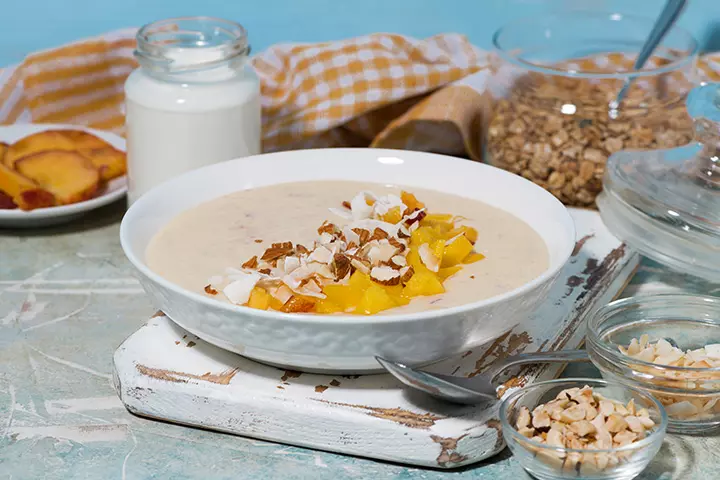
You will need:
- 1 cup almond milk
- ½ cup frozen mango
- ½ cup frozen banana
- 1tsp cashew and walnut powder
How to prepare:
- Put all the ingredients into a blender and blend into a smooth, lump-free smoothie.
- Pour the smoothie into a serving bowl and feed the baby immediately.
- Alternatively, you can freeze the smoothie for two hours to convert the smoothie into a sorbet.
 Quick tip
Quick tip5. Peanut butter yogurt (12 months)
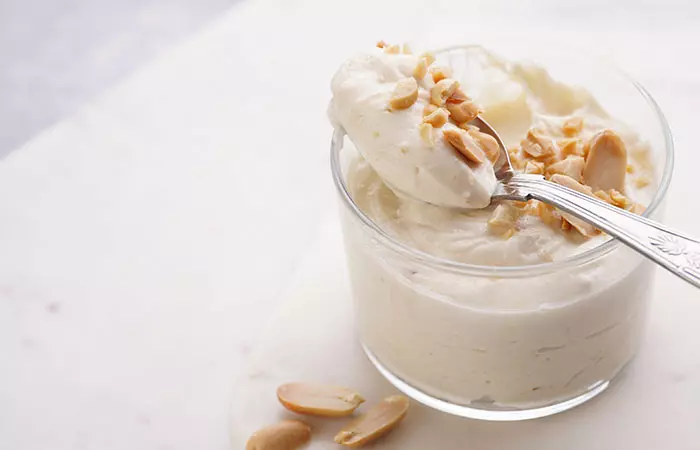
You will need:
- 1 cup plain yogurt
- 3tbsp peanut butter, smooth or crunchy
- ½-1tsp cinnamon
- 2-3tsp date syrup
- 1-2tbsp finely grated carrots
- Toppings as desired
How to prepare:
- Combine yogurt, peanut butter, cinnamon, and grated carrots in a medium-sized bowl.
- Stir until smooth.
- Adjust sweetness by adding date syrup if desired.
- Customize your bowl with preferred toppings.
- Serve immediately or refrigerate in an airtight container for up to one week. Remember to stir before serving.
Frequently Asked Questions
1. What should I do if my baby has an allergic reaction to nuts?
If you notice symptoms of nut allergy such as nausea, shortness of breath, and difficulty swallowing, you must immediately stop your child from consuming the food and take them to the doctor (15). The doctor may evaluate the symptoms and accordingly may give epinephrine shots (16).
2. Can babies outgrow peanut allergy?
About 20% of children may outgrow their peanut allergy when they get older. But there might still be some chance of its reoccurrence (17).
3. How are babies tested for nut allergies?
Babies may be tested for nut allergies by the standard skin prick test or a blood test to determine the child’s reaction to peanuts (18).
4. What percentage of the population is allergic to tree nuts?
About 0.5-1% of the US population has a tree nut allergy. It includes allergies to Brazil nuts, almonds, walnuts, cashews, macadamia nuts, hazelnuts, pecans, pine nuts, and pistachios (19).
5. What makes a baby at high risk for peanut allergy?
Based on new clinical trials, the guidelines suggest that children with severe eczema, egg allergy, or both are at high risk of developing peanut allergies (20).
Nuts are packed with essential nutrients and energy beneficial for babies and toddlers. Incorporate nuts into your baby’s diet as a fine paste or nut milk since whole nuts may be a choking hazard. It is also necessary to ensure that your baby is not allergic to one or more tree nuts. You may initially give small amounts of one kind of nut paste to look for allergies. If your baby shows allergic reactions to nuts, avoid giving them nut products and check labels for foods that may get cross-contaminated with nuts in the manufacturing process.
Infographic: Making Nut Powder For Babies At Home
Nuts are storehouses of nutrition, and a blend of nuts can fulfill your baby’s nutritional needs. A mixed nut powder may be stored and added to various dishes for your baby. However, you must ensure that your baby does not have nut allergies. The infographic below provides a recipe for a healthy mixed nut powder suitable for babies.
Some thing wrong with infographic shortcode. please verify shortcode syntax
Illustration: Nuts For Babies: When To Introduce Benefits And Recipes

Image: Stable Diffusion/MomJunction Design Team
References
1. Foods to avoid giving babies and young children;NHS UK
2. David M. Fleischer, Early introduction of allergenic foods may prevent food allergy in children; American Academy of Pediatrics
3. Carla Kemp,Will early introduction of foods prevent allergies?American Academy of Pediatrics
4. Choking Hazards; CDC
5. Your Challenge – Choose Nuts and Seeds More Often;Dietitians of Canada
6. The crucial brain foods all children need;Harvard Medical School
7. Penny M Kris-Etherton et al.,Nuts and their bioactive constituents;The American Journal of Clinical Nutrition
8. Helen Fields,The Gut: Where Bacteria and Immune System Meet;John Hopkins Medicine
9. Cesarettin Alasalvara, Jordi-SalasSalvado, and EmilioRoscd,Bioactives and health benefits of nuts and dried fruits;,ScienceDirect
10. Bradley W Bolling, Diane L McKay, and Jeffrey B Blumberg,The phytochemical composition and antioxidant actions of tree nuts;U.S. National Library of Medicine
11. Phytosterols lower cholesterol levels in a dose-dependent manner;UC Davis Department of Nutrition
12. Tree Nut Allergy;Food Allergy Research & Education
13. Tree Nut Allergy;American College of Allergy, Asthma & Immunology
14. Choking Hazard Safety;Nationwide Children’s Hospital
15. Peanut and tree nut allergy; The Royal Children’s Hospital Melbourne
16. Peanuts; American College of Allergy, Asthma, and Immunology
17. Will a child outgrow an allergy?; Anaphylaxis UK
18. New guidelines for preventing peanut allergy in babies; Harvard Medical School
19. Everything You Need to Know about Tree Nut Allergy; American Academy of Allergy, Asthma & Immunology
20. The Truth about Peanut Allergies in Kids; Children’s Hospital of Philadelphia
21. Children under five at risk eating nuts ; Epworth HealthCare
Community Experiences
Join the conversation and become a part of our nurturing community! Share your stories, experiences, and insights to connect with fellow parents.
Read full bio of Dr. Sonal Dhemla
Read full bio of Swati Patwal
Read full bio of Rohit Garoo
Read full bio of Ghazia Shah






